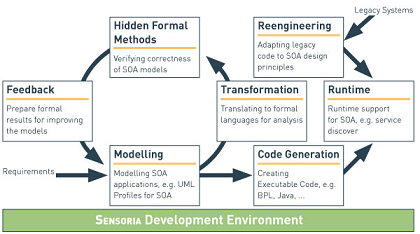|
Service-Oriented Computing (SOC) is of enormous strategic importance for society and a key
enabling technology for IT-rich areas of modern life. Several of the key concepts of Service-Oriented Computing (SOC)
are directly connected to economic benefits to IT-dependent organizations. Moving to SOC saves investments,
as existing software may be wrapped and thus made available in a more decoupled way.
By using services as the basic computational entities, developers can grow new
applications by merely combining existing services rather than having to create a new monolithic application from scratch,
while at the same time keeping the system loosely coupled. Also, the flexible nature of service interactions allows organizations to
quickly react to changes in its environment by replacing services or re-configuring/reorganizing service compositions.
The IST-FET Integrated Project SENSORIA has developed a novel comprehensive approach to deal with SOC where foundational theories, techniques and methods are fully integrated in a pragmatic toolsupported software engineering approach, addressing, for example, early verification and validation, semi-automatic development and deployment of self-adaptable (composite) services.
 SENSORIA development process support The SENSORIA techniques enable service engineers to model their applications on a very high level of abstraction using service-oriented extensions of the standard UML, or domain-specific service-oriented modelling languages to translate into hidden formal representations by automated model transformations as well as generate executable code. Our tools are able to perform checks of functional correctness of services, early performance analysis, prediction of quantitative bottlenecks in collaborating services, and verification of service level agreements. Finally, results of the mathematical analysis are made available in the models to provide feedback to the engineer.
|
